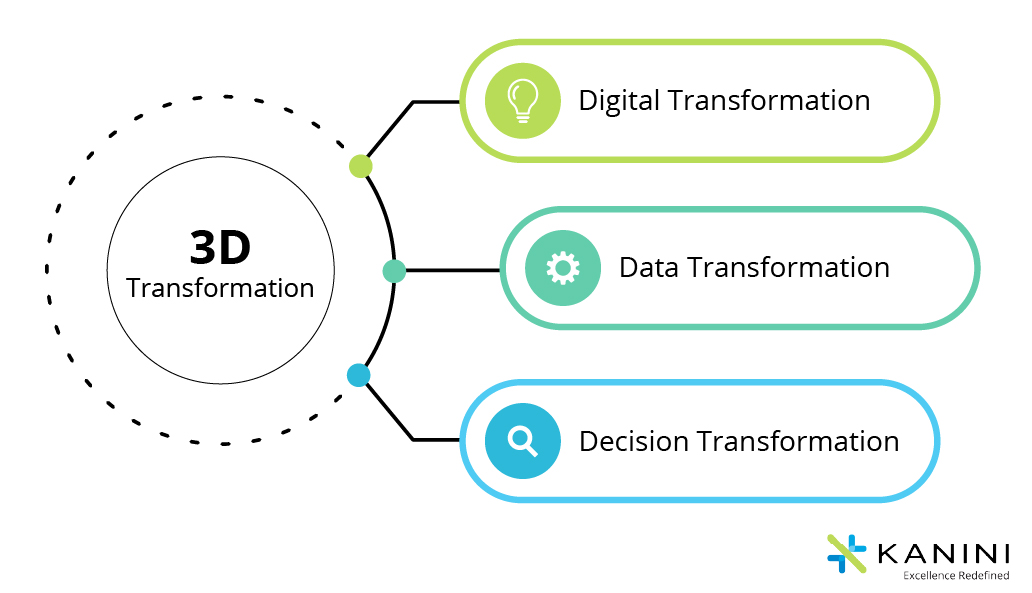Patients today are growing increasingly aware and expect superior services from providers. Patient loyalty can be very fleeting when it comes to sticking to one provider – one unpleasant experience can make them shift to a new provider. Hence, healthcare providers cannot ignore patient experiences and focus only on their operational efficiencies.
Building a Patient-Centric Business Model
An online data platform that focuses on the following 3Ds can get a healthcare organization started on its journey of building a patient-centric business.

To achieve such patient-centricity, providers must adopt ‘Patient 360’ – a comprehensive single view of the patient based on data to preempt what the patients want and yet be able to manage their operational costs to be profitable.
Let us understand why “Patient 360” is important with an example.
1. The Scene
- As soon as he called, he was addressed by his name by the personnel. (Personalized Experience)
- They asked him if he is calling for his next appointment and also thanked him for his straight feedback last time, which has helped them make some significant changes in their operations. (Opinion Mining)
- They also mentioned that John’s regular physician is available later in the week, but if he wants to advance his appointment, there is another equally good physician. (Appointment Booking)
- They requested him to check his WhatsApp for more details about the physician’s area of expertise, recent accreditations he has had, and more. (Patient Recommendations)
- Unassumingly, they also offered John that they can put him in touch with other patients that the physician has treated (without disclosing the patients’ details). (Patient Engagement)
- Finally, they also offered John a payment plan which would allow him to pay for the services in parts. (Payment Experience)
2. The Experience
3. The Inference
4. The Solution - How is Patient 360 Made Practical?
- Allow providers to become “patient curious”
- Build “data-driven intelligence” based on patient journeys
- Enable data democratization to take data-driven decisions
- Identify services that a patient might need in the future
- Analyze patient feedback and be ready to bring operational efficiencies with velocity
- Create a “patient-centric” business
Snowflake Data Cloud Platform - Your Way to the 3Ds
Here’s what the Snowflake Data Cloud Platform does for healthcare providers –
- Providers are empowered with a platform that can give them a ‘Single View of a Patient’, Patient 360, on the cloud. ‘Single View of Patient’ is so quintessential that it innately follows the ‘Patient First’ approach.
- Since the patient record is sacrosanct, this ‘Single View’ can be accessed by all departments and all systems. This helps provider organizations in proactively identifying at-risk individuals for health conditions such as Chronic Diseases, Congestive Heart failures, etc., and recommend proven treatment plans.
- Data can be very easily integrated from various provider ‘systems of records’ such as EHR/EMR, Imaging/Lab Data, Demographic Data, Financial Data, etc.
- The integration allows for better ingestion of data into cloud data lakes that are “pay as you go”.
- Snowflake’s ability to bring the concepts of Data Engineering, Data Lake, Data Warehouse, and Data Services into one unified platform is not only revolutionary but also very practical. This makes Snowflake the perfect tool to implement a ‘Single View of Patient’. Using Snowflake, providers can very easily move from a “Data Silos” to a “Data Seamless” state.
- Snowflake is a big seller of Data Democratization, which is quintessential for any provider. Data needs to be shared responsibly within the provider organization and Snowflake’s architecture makes that possible.
- Decision Transformation needs faster delivery of actionable intelligence to consuming layers. Snowflake again comes to the fore because of this in-memory data warehousing capability which allows for the faster transformation of data, and faster delivery of that data to consuming applications or data visualization tools.
- Data in Snowflake Cloud Data Platform is super secure, ensuring client confidentiality. Data can grow in Snowflake without any limits.
- Snowflake hence becomes a very critical tool in enabling a “Single View of a Patient” which enables healthcare providers to shift from simply managing patients to ensuring a delightful patient experience.
Author

Anand Subramaniam
Anand Subramaniam is the Chief Solutions Officer, leading Data Analytics & AI service line at KANINI. He is passionate about data science and has championed data analytics practice across start-ups to enterprises in various verticals. As a thought leader, start-up mentor, and data architect, Anand brings over two decades of techno-functional leadership in envisaging, planning, and building high-performance, state-of-the-art technology teams.







